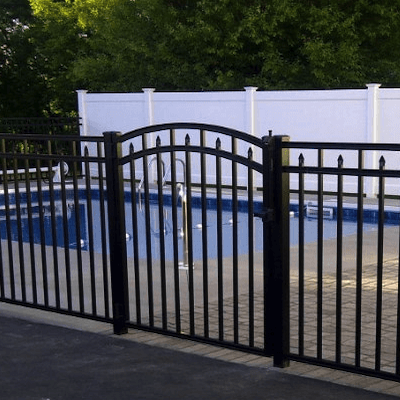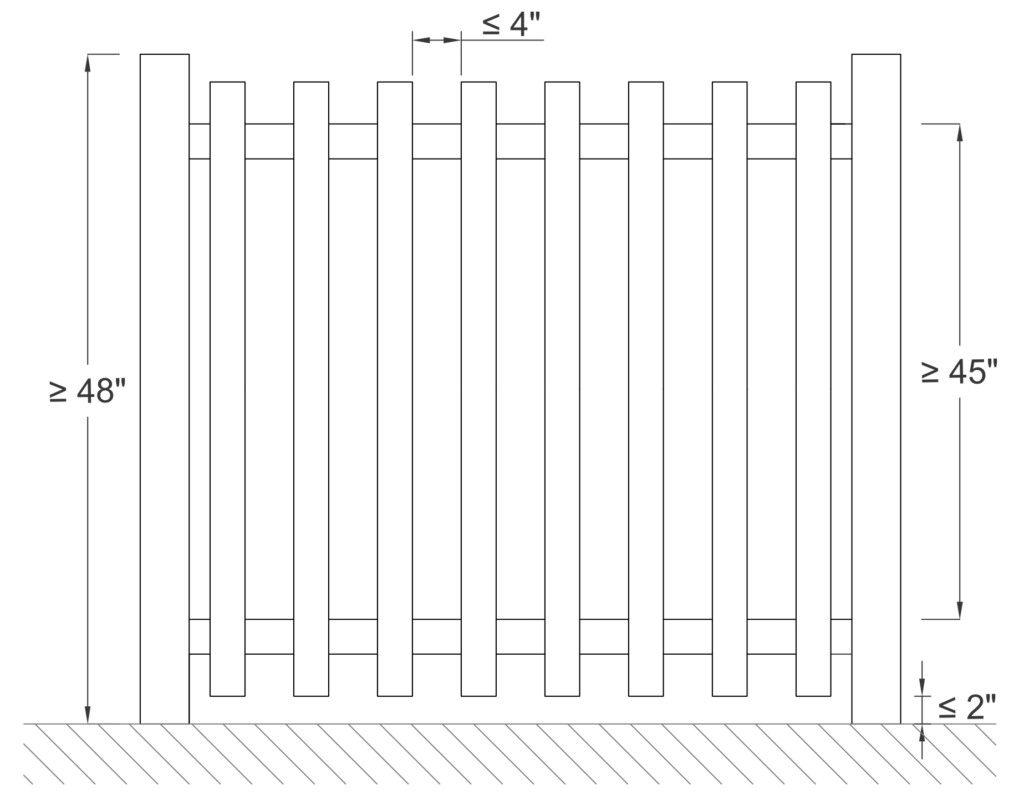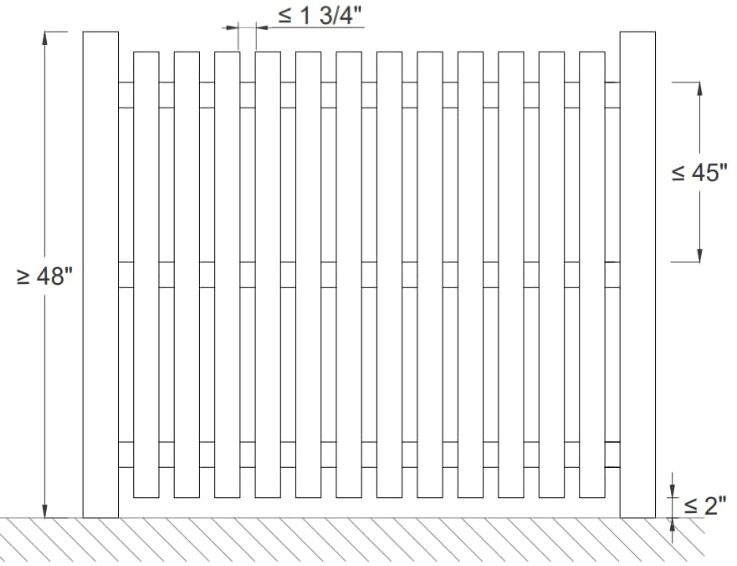Why Pool Safety Requirements Matter
All residential swimming pools must meet specific safety requirements designed to prevent accidents and protect lives, especially those of young children.
Drowning is one of the leading causes of death for children under five, and many of these incidents occur in backyard pools when adults are momentarily distracted.
To help prevent these tragedies, safety measures like barriers, gates, alarms, and covers are required by law and necessary to obtain a building permit.
In this article, we’ll cover the main pool barrier requirements that ensure your pool is both safe and legally compliant.

Approved Pool Barrier Types and Requirements
Barriers are essential to prevent young children from accessing residential swimming pools without supervision. To ensure safety, different types of pool barriers and protective measures are allowed by law.
These requirements are outlined in Section R4501.17 of the Florida Building Code (FBC), which closely aligns with the nationally recognized standards of the International Swimming Pool and Spa Code (ISPSC), specifically Section 305.2.
Meeting these safety standards requires choosing and applying one of the following approved methods (click on each for more information):
1) Safety Pool Cover Complying with ASTM F 1346.
A safety pool cover is designed to completely cover the pool surface and prevent accidental drowning, especially of young children and pets.
To be considered a legal safety barrier, the cover must meet the ASTM F1346 standard, which ensures it can support the weight of a child or pet without collapsing. This standard tests the cover’s strength, durability, and resistance to wear from sun and weather exposure. Safety covers can be manual or automatic, but both types must comply with ASTM F1346.
Regular maintenance and inspection are important to keep the cover effective, and while these covers offer significant protection, they should be used alongside other safety measures and proper supervision.

2) Continuous One-Piece Barriers (Fences and Screens) Complying with Section 305.2 of the ISPSC
A continuous one-piece barrier, such as a fence, child safety fence, or screen enclosure, is a widely used method to secure a pool area.
To qualify as an approved safety measure, the barrier must completely enclose the pool and meet the standards set by Section 305.2 of the International Swimming Pool and Spa Code (ISPSC). This includes a minimum height of 48 inches and a design that prevents climbing or access through openings. Gates must swing outward, away from the pool area, and be both self-closing and self-latching for added safety. The latch mechanism must be located at least 54 inches above the ground to keep it out of reach of small children.
Fences must meet specific dimensional requirements depending on their layout:
1. Barriers Without Closely Spaced Horizontal Members
For fences without horizontal members or with horizontal members spaced more than 45 inches apart, the barrier must be at least 48 inches high, with no openings that allow a 4-inch sphere to pass through. However, If the fence includes decorative cutouts within vertical elements, the openings must be no wider than 1.75 inches. The bottom gap cannot exceed 2 inches , or 4 inches if mounted on an elevated pool structure.
2. Barriers With Closely Spaced Horizontal Members
If the fence has horizontal members spaced less than 45 inches apart, the horizontal members must be located on the pool side of the fence to prevent them from being used as a climbing aid. Additionally, any vertical spacing between pickets or slats must be no more than 1.75 inches apart to prevent footholds.

Barriers Without Closely Spaced Horizontal Members

Barriers With Closely Spaced Horizontal Members
3. Chain-Link, Lattice, and Diagonal Members
• Chain-link fences, lattice or diagonal members must have openings no larger than 1.75 inches in width to prevent climbing.
3) Dwelling Walls with Secured Doors and Alarm Systems
In some pool layouts, part of the perimeter may be enclosed by the exterior walls of a home (the dwelling), while the rest is secured using non-dwelling structures such as fences, screen enclosures, or other approved barriers.
This hybrid approach is acceptable as long as all sides of the pool are protected, and the non-dwelling barriers meet the requirements of Section 305.2 of the International Swimming Pool and Spa Code (see option 2 about Continuous One-Piece Barriers Complying with Section 305.2 of the ISPSC). For example, if a home’s back wall forms one side of the barrier, the remaining sides must be enclosed with compliant fences or screens to fully secure the area.
Dwelling Wall Requirements: Self-Closing Devices and Alarms
When a wall of the home forms part of the pool barrier, special attention must be given to doors and windows that provide direct access to the pool area. These openings are considered potential entry points and must be secured to prevent unsupervised access by young children. To comply with safety requirements, all doors leading to the pool must be equipped with self-closing and self-latching devices. Alternatively, approved exit alarms that meet safety standards can be installed on these doors and windows to alert homeowners when they are opened. In some cases, pool alarms placed in the water may also be used as an added layer of protection, but they do not replace the need for physical barriers or secured access points.

Additional Pool Safety Requirements
Other building code requirements also play a vital role in ensuring pool safety by addressing various practical details that help prevent accidents. Below are some essential rules that complement the main barrier standards:
– Safe Distance from Pool Edge: Barriers must be installed a safe distance away from the pool’s edge to prevent a child or vulnerable person who manages to breach the barrier from immediately falling into the water.
- – Clearance Around Barriers: The area within 36 inches on the pool side of the barrier must remain free of any objects or plants that could assist in climbing.
- – Maintenance of Gates and Barriers: Gates and barriers should be kept in good condition, free of damage or gaps that could compromise their effectiveness.
- – Visibility for Supervision: Barriers should allow clear visibility into the pool area to facilitate proper supervision at all times.
- – Emergency Access Considerations: Gates must open easily, and keys or access codes should be readily available to emergency responders.
- – Final Inspection: A complete inspection of electrical systems and barrier code compliance must be conducted and approved before filling the pool with water.
- – Aboveground Pools and Access Control: For aboveground pools, the pool structure itself may serve as the barrier, or a compliant barrier can be mounted on top of it. Additionally, any ladder or steps providing access to the pool must be capable of being secured, locked, removed, or enclosed by a compliant barrier to prevent unauthorized entry. Both the structure and access controls must fully meet all applicable safety requirements.
- – Natural Barriers: When a pool or spa borders a lake or natural body of water with no public shoreline access, and the barrier extends at least 18 inches beyond the water’s edge, an additional barrier between the pool and the shoreline is not required.
- – Natural Topography: Features like mountains or rock formations that naturally block access may be accepted as barriers if approved by the governing body and provide protection equivalent to Sections 305.2–305.5.
This article has covered some of the main requirements regarding pool safety regulations. However, be sure to consult your local building codes to ensure your pool enclosure meets all applicable rules. Always reach out to a licensed engineer for expert advice and guidance tailored to your specific project.
For more detailed information and professional support on your future projects, don’t hesitate to contact us. If you have any questions or want to learn more about our services, simply get in touch—click the buttons below to get started.
For more detailed information and guidance on handling your future design projects, check out our online design calculators, contact us for site-specific projects, or reach out to us with your inquiries.
Explore More About Fence Safety & Design
Understanding Fence Design: Key Considerations and Code Requirements
Fences – An Overview Fences serve multiple purposes, from enhancing privacy and security to defining property boundaries and improving aesthetics. However, a well-designed fence isn’t
How To Calculate Porosity of a Louver – Sign – Fence Per ASCE 7
Porosity – How ‘Open’ A Surface Is – Explained The porosity of open structures is defined in ASCE-7 standard under ‘open signs’ (chapter 29, as
How To Obtain a Building Permit
The journey from project idea to completion is not just about building; it’s about understanding construction codes and securing the necessary approvals to move your
FAQ I’m a contractor looking to purchase a fence / gate or similar plan. What do I do?
Engineering Express allows homeowners & contractors to purchase pre-engineered master plans from our Online Plan Store for a number of building component categories. These plans
FAQ I’m a homeowner looking for a fence & gate (or similar) plan for permit. What do I do?
Engineering Express allows homeowners & contractors to purchase pre-engineered master plans from our Online Plan Store for a number of building component categories. These plans
ASCE Wind Speed Risk Category To Use with Signs – Fences & Building Components On-Off Buildings
This topic has been merged with our main ASCE 7 Risk Category Knowledge Base Article. See this page and scroll to the bottom for an
Last Update: May 29, 2025
Related Knowledge Base Posts -
No related posts found !